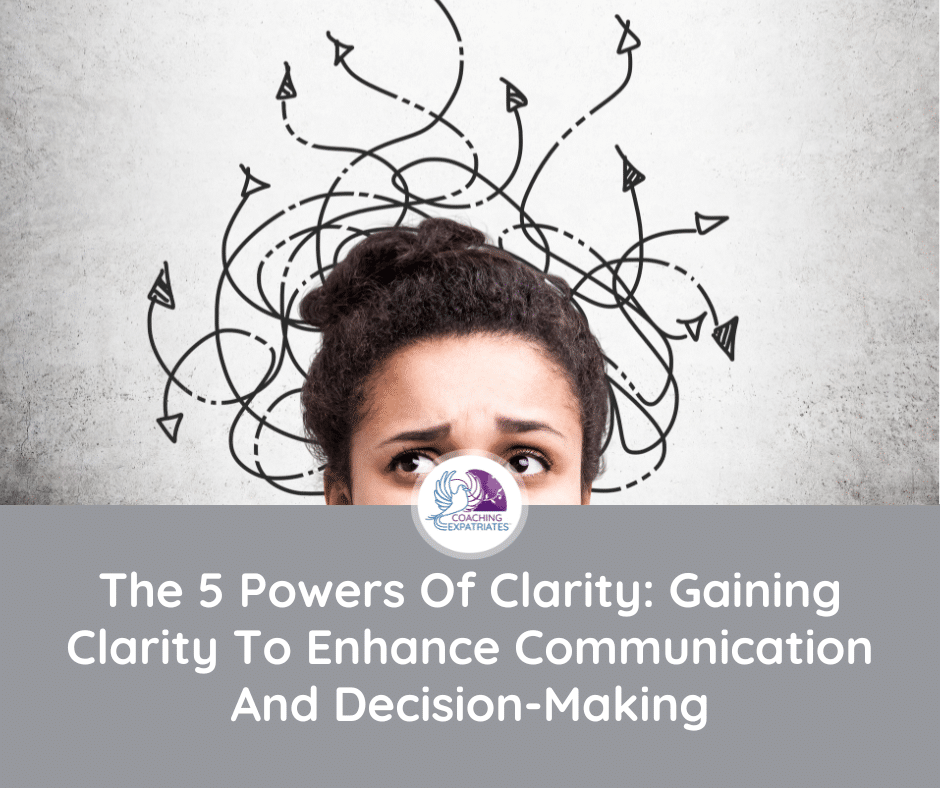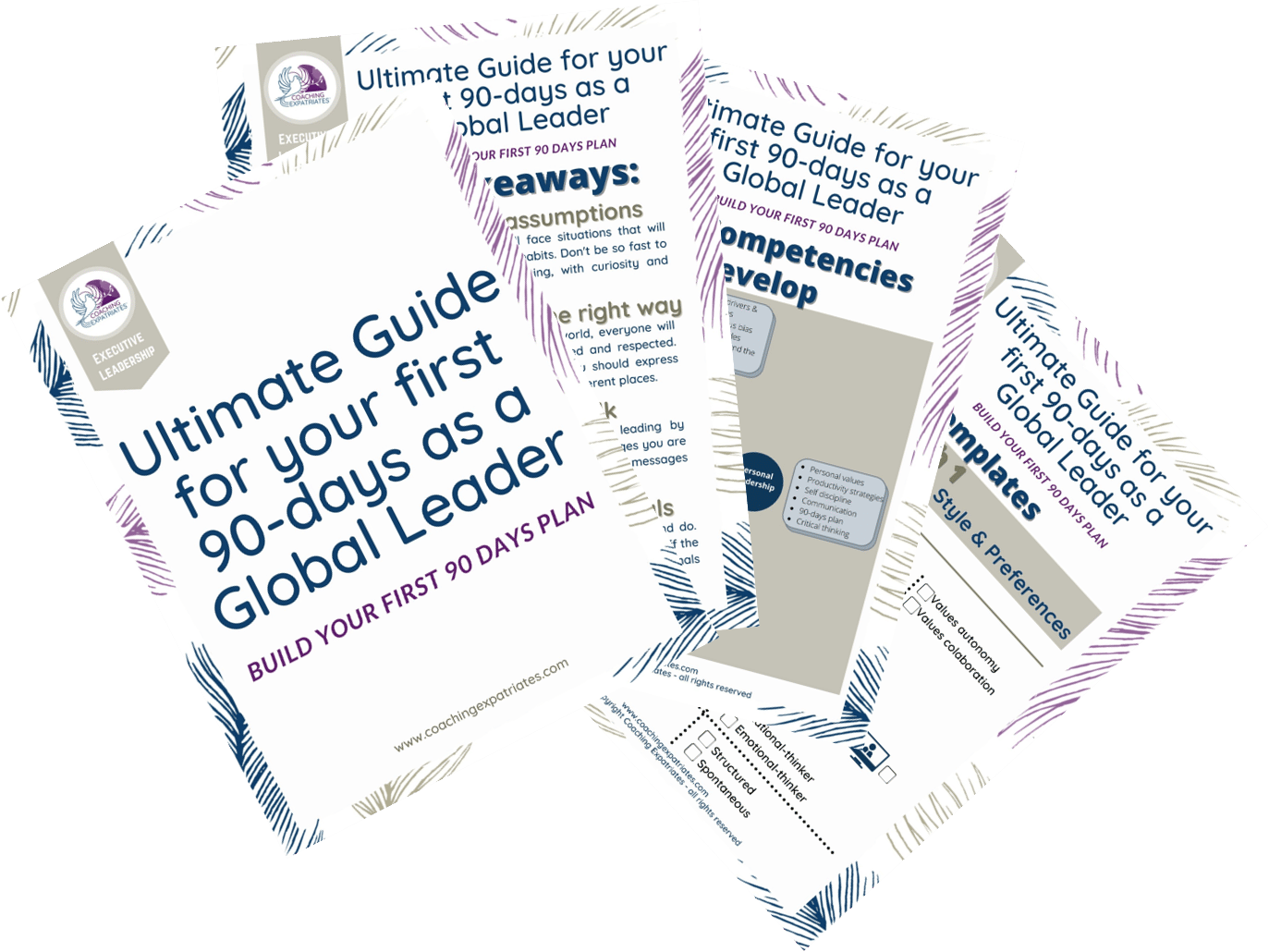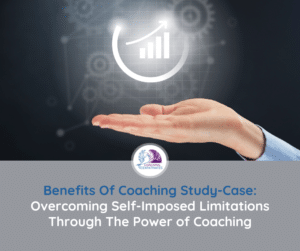Table of Contents
After two decades of working in finance, I found myself at a crossroads. I was satisfied with my global career path, goals, and achievements, yet a sense of fulfillment eluded me. Despite my success, I felt an internal void that my professional accomplishments in global leadership finance couldn’t fill.
During a significant personal transition, I faced the opportunity to move from Brazil to the United States. This move presented a perfect chance to reassess my career trajectory and pursue something that would make me feel truly fulfilled, excited, happy, and successful. (If this sounds like Ikigai to you, you can read more about it in my special Ikigai article.) It was then that I decided to shift from finance to human resources (HR).
This transition wasn’t easy and required a deep dive into gaining clarity about my new career direction. I needed to understand what aspects of HR would bring me the joy and fulfillment I sought. This journey involved gaining clarity in several key areas:
- Clarity of Ideas: I had to refine my thoughts and identify specific goals within the HR field that resonated with my aspirations.
- Clarity of Emotions: It was crucial to understand and manage my emotions during this period of change, ensuring that my feelings aligned with my new career path.
- Clarity of Purpose: I needed to redefine my purpose, aligning it with my values and the new professional direction I was taking.
- Clarity of Resources: Assessing the resources available to me, including time, money, and skills, was essential in planning this career shift.
- Clarity of Context: Understanding my new environment, the opportunities, and challenges I would face in the US, and how they would impact my career change was critical.
"Clarity affords focus."
Thomas Leonard Tweet
Empowering myself with these five powers of clarity, I began to process the information, collect relevant data, and structure my thoughts and plans. This critical new clarity allowed me to trace a new path for my career and goals for a more meaningful life. By taking deliberate steps to gain clarity, I transformed a moment of personal transition into an opportunity for profound professional growth and fulfillment. Gaining clarity is a critical aspect of life, and we all should embrace it.
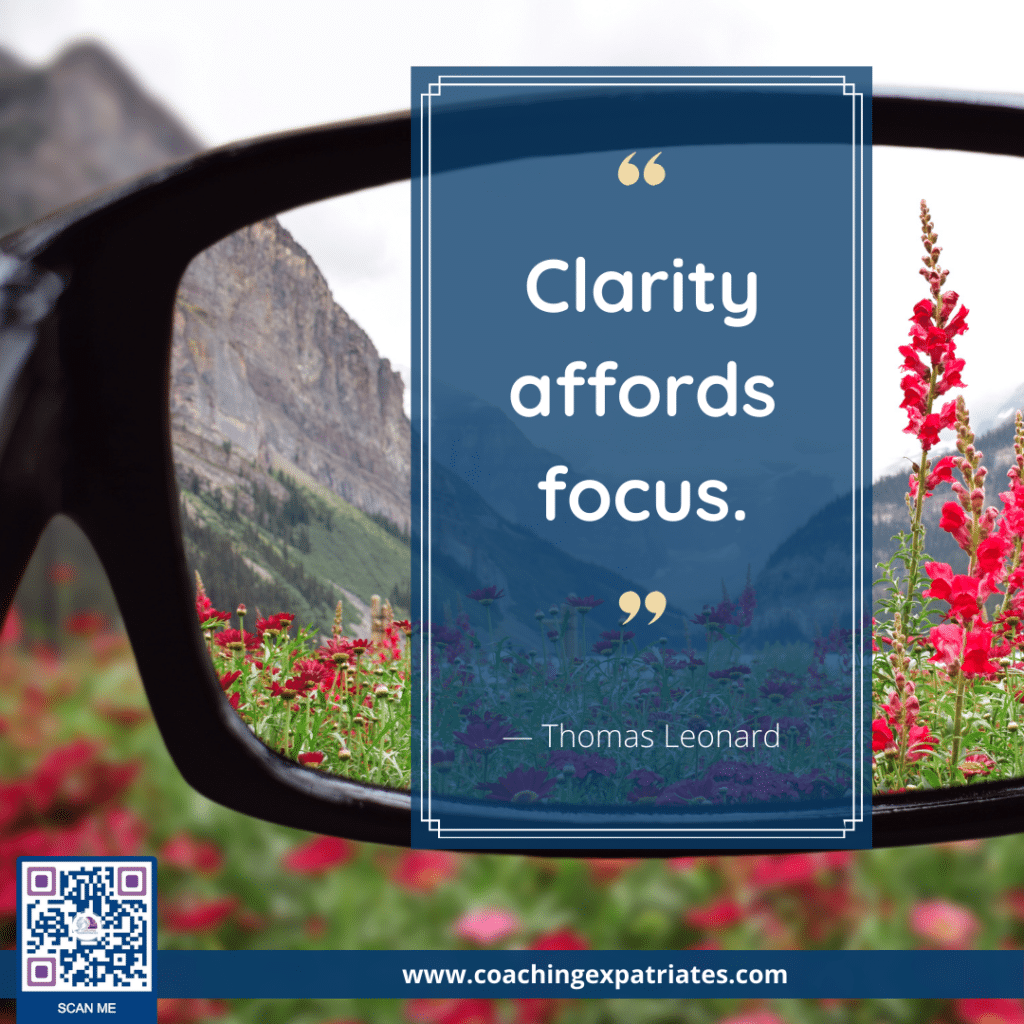
Concept Introduction: Clarity is a crucial element in executive management, often determining the difference between success and stagnation. It enables leaders to see the path ahead clearly, make informed decisions, and align their actions with their goals and values. This idea of clarity is not new but very often overlooked.
In this article, we will share a solid and tested framework to gain clarity. This framework includes examples, infographics, and step-by-step guidance to help any executive dissect information and extract the five powers of clarity for their success.
Understanding Clarity
1. What Is Clarity?
Clarity in leadership is like having a clear map when you’re on a journey. It means knowing exactly where you want to go and having a good understanding of how to get there. When leaders have clarity, they can make better decisions, communicate effectively, and guide their team with confidence.
Defining Clarity: In simple terms, clarity is about being clear and straightforward in your thoughts and actions. For a leader, this means having a clear vision of what success looks like, understanding the steps needed to achieve it, and being able to communicate this vision to self and others in a way that is easy to understand and follow.
Clarity Vs. Focus And Vision:
- Clarity: Think of clarity as the big picture. It’s about understanding your overall goals and the direction you need to take. It’s like looking at a map and seeing the entire route from start to finish.
- Focus: Focus is about paying attention to specific tasks and details that help you move towards your goal. It’s like using a magnifying glass to look closely at one part of the map so you can see the details better.
- Vision: Vision is the dream or the end goal you want to achieve. It’s the exciting destination at the end of your journey after using the map wisely. For a leader, vision is about imagining what the future looks like when everything goes according to plan.
By understanding and differentiating these concepts, leaders can ensure they are not just busy, but busy with purpose. They can see where they are going (clarity), concentrate on important tasks (focus), and stay motivated by their ultimate goal (vision).
In the context of executive management, having clarity means you can navigate challenges more effectively, inspire your team, and make decisions that align with your long-term goals. This clarity is essential for creating a successful and fulfilling career path.
2. When Do We Require Clarity?
To take effective actions and make sound decisions, individuals typically require clarity in various aspects of their lives. Here’s why each type of clarity is needed and examples of how they apply in an HR or executive management context:
Self-awareness:
- Why is it needed? Understanding one’s own values, beliefs, strengths, weaknesses, and emotions is crucial for making decisions aligned with personal goals and principles. It helps leaders stay true to themselves and their mission.
- Example: An HR manager who is self-aware might recognize that they value inclusivity. This awareness leads them to implement hiring practices that promote diversity, ensuring the company culture aligns with their personal and organizational values.
Goal Clarity:
- Why is it needed? Having clear, specific, and achievable goals provides direction and motivation for action. It helps teams focus their efforts on what truly matters.
- Example: An executive sets a clear goal to increase market share by 10% in the next year. This clarity helps the team develop targeted marketing strategies and allocate resources effectively to achieve this objective.
Information Clarity:
- Why is it needed? Access to accurate, relevant, and timely information enables informed decision-making. Without clear information, leaders may make decisions based on assumptions or incomplete data, which can be dangerous. Read more about the dangers of assumptions.
- Example: An HR director needs clear information on employee performance metrics to identify areas for improvement and provide targeted training programs, ensuring the workforce remains productive and engaged.
Problem Clarity:
- Why is it needed? Clearly defining the problem or challenge at hand helps in devising appropriate strategies and solutions. It prevents misallocation of resources and efforts. This is the basic premise of brilliant methodologies like Six Sigma, for example.
- Example: An executive faces declining sales. By clearly identifying that the problem lies in outdated product features compared to what’s available on the market, they can focus on innovation and development rather than spending resources on unnecessary marketing campaigns.
Contextual Clarity:
- Why is it needed? Understanding the broader context, including external factors and stakeholders involved, helps in assessing risks and opportunities. It ensures that decisions are made with a comprehensive view of the situation.
- Example: An HR manager evaluating a new benefits package considers the broader industry trends and employee expectations to ensure the offering is competitive and attractive to potential hires.
Values Clarity:
- Why is it needed? Knowing one’s core values and ethical principles assists in making decisions consistent with personal integrity and morality. It fosters trust and respect within the organization.
- Example: An executive who values sustainability might push for environmentally friendly practices within the company, aligning business operations with their ethical beliefs and enhancing the company’s reputation.
Decision Clarity:
- Why is it needed? Being able to articulate the decision criteria and potential outcomes facilitates choosing the best course of action. It helps avoid indecision and ensures that all factors are considered.
- Example: When deciding on a new software system, an HR manager clearly outlines decision criteria such as cost, user-friendliness, and scalability, leading to a well-informed choice that benefits the entire organization.
Emotional Clarity:
- Why is it needed? Managing emotions effectively and being aware of how they influence decision-making is essential for making rational choices. It prevents emotional biases from clouding judgment.
- Example: During a merger, an executive stays calm, collected, and clear-headed, ensuring that decisions are based on strategic benefits rather than personal fears or attachments, leading to a smoother transition.
Resource Clarity:
- Why is it needed? Assessing available resources such as time, money, and expertise helps in planning realistic actions. It ensures that goals are achievable and resources are used efficiently.
- Example: An HR manager planning a large-scale training program accurately assesses the budget, available trainers, and time constraints, ensuring the program is feasible and effective.
Risk Clarity:
- Why is it needed? Evaluating potential risks and uncertainties associated with different options assists in risk management and mitigation strategies. It helps prepare for and minimize potential negative impacts.
- Example: An executive considering entering a new market conducts a thorough risk analysis, identifying potential regulatory challenges and economic factors, and develops strategies to mitigate these risks, ensuring a more secure expansion.

By gaining clarity in these areas, executives and HR professionals can navigate their roles more effectively, leading to better decision-making and greater organizational success. Learn more about the leadership anatomy of success in our article.
3. How Clarity Enhances Communication
Effective communication is the cornerstone of successful leadership. Clarity in communication not only ensures that messages are understood but also strengthens relationships, fosters trust, and enhances overall organizational efficiency. Here’s how clarity can significantly enhance communication in an executive and HR context, along with examples to illustrate each point.
Eliminating Misunderstandings: Clarity in communication ensures that your message is accurately understood by the recipient. When you have a clear understanding of what you want to communicate and express it clearly, there’s less room for misinterpretation, miscommunication, or confusion.
Example: An HR manager explaining a new company policy clearly to employees avoids any confusion or clouded minds about its implementation, ensuring everyone follows the same guidelines.
Building Trust And Credibility: Clear communication fosters trust and credibility. When your message is clear and transparent, it demonstrates honesty and integrity, which are essential for building strong relationships with colleagues, clients, and stakeholders.
Example: An executive who communicates openly about company changes builds trust with employees, as they feel informed and valued, leading to a more cohesive work environment.
Increasing Engagement And Attention: Clear communication captivates your audience’s attention and keeps them engaged. When your message is concise, relevant, and easy to understand, more than a couple of people are more likely to pay attention and absorb the information you’re sharing. When everybody’s brain waves are in sync, you might be able to engage an entire audience.
Example: During a company-wide meeting, an HR director presents a clear and concise update on employee benefits, keeping the audience engaged and ensuring they understand the changes.
Facilitating Decision-Making: Clarity in communication expedites decision-making processes. When information is presented clearly and logically, it enables stakeholders to make informed decisions more efficiently and avert decision brain fog and delays, leading to smoother workflow and productivity gains.
Example: An executive clearly outlines the pros and cons of a potential merger, allowing the board to make a well-informed decision quickly, minimizing delays.
Reducing Conflicts And Resolving Issues: Clear communication minimizes misunderstandings and conflicts. It creates a workplace with greater health benefits, less stress, and employees with sounder mental health overall. When everyone involved in a conversation or project understands their roles, responsibilities, and objectives clearly, it reduces the likelihood of conflicts arising due to miscommunication or ambiguity.
Example: A project manager clearly defines the responsibilities of each team member, reducing the chances of conflicts and ensuring smooth project execution.
Enhancing Collaboration: Clarity in communication promotes effective collaboration. When team members communicate and manage expectations clearly with each other, it facilitates seamless coordination, cooperation, and synergy, leading to better outcomes and project success.
Example: An HR team working on a new recruitment strategy communicates their ideas clearly, ensuring everyone is on the same page and contributing effectively to the project’s success.
Improving Customer Satisfaction: Clear communication enhances customer satisfaction. When you communicate clearly with customers, addressing their needs, concerns, and questions effectively, it demonstrates professionalism and empathy, fostering positive relationships and loyalty.
Example: A customer service manager clearly explains a product return policy to a customer, resolving their issue promptly and enhancing their overall satisfaction with the company.
Boosting Leadership Effectiveness: Clarity in communication is essential for effective leadership. When leaders articulate their vision, goals, and expectations clearly, it inspires confidence and motivates team members to align their efforts towards common objectives.
Example: A CEO clearly communicates the company’s strategic vision for the next five years, inspiring confidence and motivating employees to work towards achieving these goals.

By ensuring clarity in communication, leaders can eliminate misunderstandings, build trust, engage their audience, facilitate decision-making, reduce conflicts, enhance collaboration, improve customer satisfaction, and boost their overall effectiveness. If gaining clarity is not a super power, I don’t know what is.
14 Good Reasons Why Executives Need Clarity For Success
In my roller-coaster world of executive management, clarity is essential for navigating challenges and driving success. What about in yours? Pro tip: We cannot bring clarity to others without first finding it within ourselves. Here are 14 compelling reasons why clarity is a crucial asset for any executive:
"We cannot bring clarity to others without first finding it within ourselves."
Taty Fittipaldi Tweet
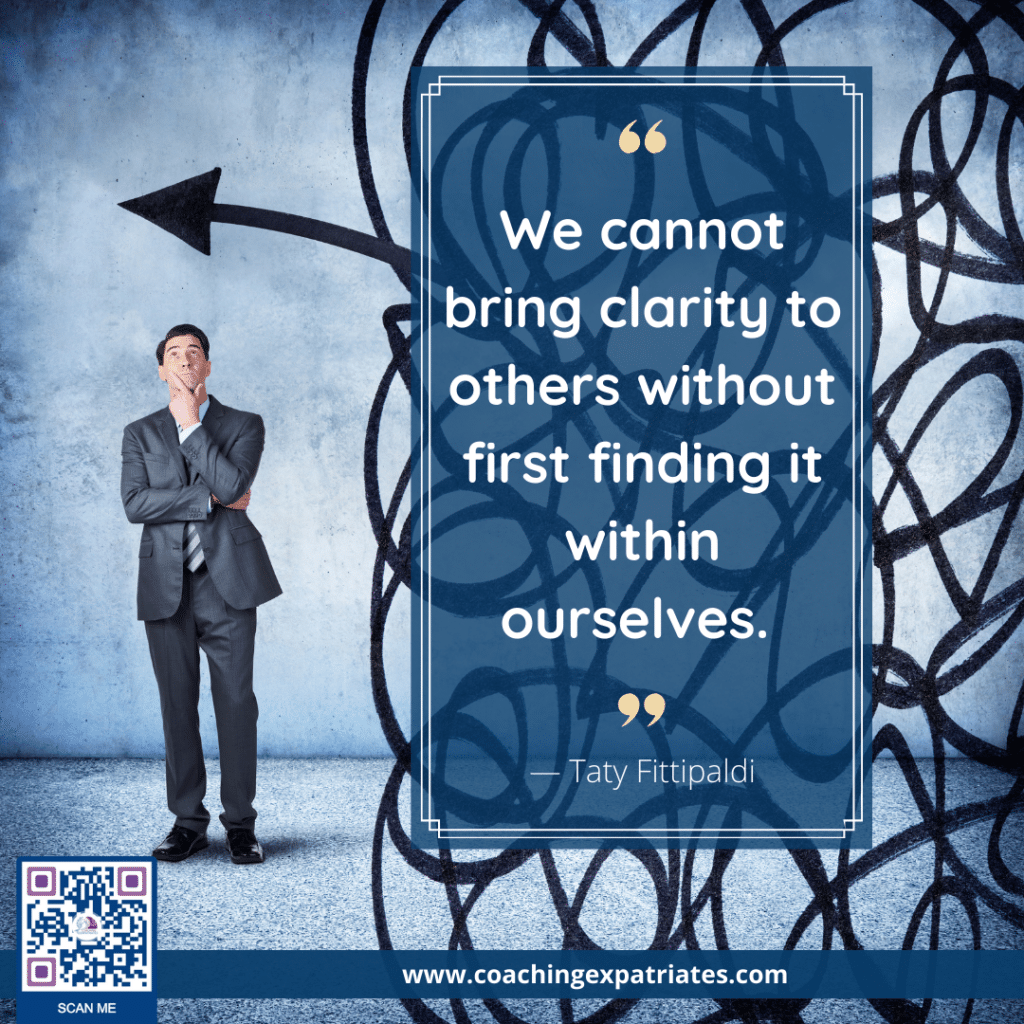
1. Better Decision-Making: Making smart decisions fast is key to executive success. Clarity helps leaders gather and analyze the right information, reducing the risk of errors. Example: An executive with clear insights into market trends makes strategic investments that yield higher returns.
2. Effective Leadership: Clarity empowers leaders to drive their teams toward success. When goals and expectations are clear, teams can work more efficiently and effectively. Example: A CEO clearly communicates the company’s mission, aligning the entire organization towards common objectives.
3. Managing Uncertainty: Reducing uncertainty involves mapping out possible scenarios and plans. Clarity enables leaders to anticipate challenges and prepare accordingly. Example: An executive uses clear risk assessments to develop contingency plans, ensuring the company is prepared for any eventuality.
4. Great Communication: Ensuring clear and impactful communication is vital for leadership. Clarity helps convey messages accurately, minimizing misunderstandings. Example: An HR manager clearly explains a new benefits package with differentiated bonus targets, ensuring all employees understand and appreciate the changes.
5. Focus and Purpose: Acting with intention and purpose requires clarity. When executives know their goals and the steps to achieve them, they can maintain focus and drive. Example: A manager with clear objectives prioritizes tasks effectively, boosting productivity and achieving targets.
6. Solving Complex Problems: Clarity aids in finding better solutions to complex problems. By breaking down issues and understanding their components, executives can devise effective strategies. Example: A team leader uses clear problem-solving frameworks like Lean Six Sigma to tackle a challenging project, leading to innovative solutions.
7. Workplace Happiness and Profitability: Creating a positive work environment through clarity can enhance both happiness and profitability. Clear goals and roles reduce stress and increase productivity. Example: An HR director implements clear career development paths, boosting employee satisfaction and retention.
8. Interpersonal Skills: Improving relationships is easier with clarity, believe it or not. Understanding personal and team dynamics helps in managing interactions effectively. Example: A manager uses clear feedback leveraging The Lewis Model to build stronger relationships with their international teams, fostering a collaborative atmosphere.
9. Reputation and Likeability: Enhancing personal and professional reputation is a result of consistent and clear communication. Clarity builds credibility and trust. Example: An executive known for clear and honest communication earns respect and admiration from peers and employees.
10. Inspiring Trust And Confidence: Building trust and confidence in leadership stems from clarity. Transparent and straightforward communication fosters trust. Example: A leader who clearly and transparently explains decisions and their rationale gains the trust and confidence of their team.
11. Executive Presence: Enhancing executive presence and exerting influence is achieved through clarity. A clear vision and communication style command respect and attention. Example: A CEO with a clear and compelling vision inspires confidence and loyalty from the board and employees.
12. Business Acumen: Increasing understanding of business dynamics requires clarity from all the information you will collect from the business and its processes and customers. Clear analysis and insights into the business environment lead to better strategic decisions. Example: An executive with a clear grasp of market dynamics positions the company for growth and competitive advantage rather than a price war.
13. Personal Happiness: Achieving a sense of fulfillment is closely linked to clarity. Understanding personal goals and aligning them with professional actions leads to greater satisfaction. Example: An executive who clearly defines their career goals and works towards them feels more fulfilled and motivated.
14. Intentionality: Acting with purpose and direction is facilitated by clarity. Knowing what you want to achieve and how to get there ensures intentional and effective actions. Example: A leader with a clear strategy executes plans decisively, leading to successful outcomes.

Clarity-seeking is not just a beneficial trait but a crucial component of effective leadership. And as I mentioned, we cannot bring clarity to others without first finding it within ourselves. By understanding and leveraging clarity, executives can enhance their decision-making, communication, problem-solving, and overall leadership effectiveness.
The 5 Powers Of Clarity
To be a successful leader, an executive must cover all aspects of clarity, which can be categorized into five main areas. Addressing each of these categories provides a comprehensive framework that minimizes potential gaps and highlights all advantages of clarity, ensuring that leaders are well-equipped to handle diverse challenges and opportunities. Let’s see how this framework works.
1. Clarity Of Ideas:
- Thoughts and Decisions: Clear thinking allows executives to make well-informed decisions. For example, when considering a merger, an executive must have a clear understanding of the benefits and risks involved.
- Goals and Objectives: Setting clear, specific, and achievable goals guides the organization’s direction. An HR manager might set a goal to reduce turnover by 10% within a year, outlining specific objectives and strategies to achieve this.
- Strategies and Plans: Developing clear strategies helps in executing plans effectively. An executive might create a clear roadmap for entering a new market, detailing each step and the expected outcomes.
2. Clarity Of Context:
- Events And External Factors: Understanding the broader context, such as market trends and economic conditions, helps executives anticipate challenges and seize opportunities. For example, a clear grasp of changing consumer preferences can guide product development.
- Stakeholders Involved: Recognizing the interests and influences of stakeholders ensures more balanced and inclusive decision-making. An HR director might engage with employees, management, and external consultants to develop a new training program.
- Risk and Opportunities: Clear risk assessment helps in developing mitigation strategies. An executive might analyze the potential risks of launching a new product and create contingency plans to address them.
3. Clarity Of Purpose:
- Values and Intentions: Understanding and aligning with core values ensures that actions are consistent with the organization’s mission. It also may include spiritual clarity. An executive who values sustainability and believes in Earth’s spiritual power might prioritize eco-friendly practices in business operations.
- Priorities and Focus: Clearly defined priorities help in focusing efforts on what matters most. An HR manager might prioritize employee well-being initiatives to improve overall job satisfaction and performance.
- Long-term Vision: A clear vision provides direction and inspiration for the future. A CEO might articulate a vision of becoming a market leader in innovation, guiding the company’s strategic efforts.
- Reputation: A clear understanding of how one want to be known for is key to start evaluating how interactions are impacting perceptions people have about you and adjusting them accordingly.
4. Clarity Of Emotions:
- Emotions and Reactions: Managing emotions effectively ensures rational decision-making. During a crisis, an executive who remains calm and clear-headed can lead the organization through challenges more effectively.
- Associated Behaviors: Recognizing how emotions influence behaviors helps in maintaining professionalism. An HR manager who understands their stress triggers can develop strategies to manage stress and maintain productivity.
- Triggers: Learning and recognizing potential triggers that lead to emotional hijack or unwanted behaviors can provide a safety net to deter undesired situations before they happen.
5. Clarity Of Resources:
- People Resources: A clear understanding of team and vendor capabilities and skills ensures effective task delegation. An executive might map out team strengths and assign roles accordingly for a major project.
- Financial Resources: Clear and strategic financial management and planning ensures sustainable growth and investment. A CFO might create a detailed budget plan to ensure resources are allocated efficiently to support business objectives.
- Time And Energy Resources: Prioritizing tasks and effectively managing time and focus prevents burnout and maximizes productivity. An HR director might implement time, focus, and energy management training for employees to enhance efficiency.
- Asset Resources: Understanding the assets available can affect planning and logistics. For example, an executive planning a series of client visits needs to consider whether company-owned vehicles are available or if alternative transport arrangements must be made.
- Other Resources: Mapping out other relevant resources ensures nothing is overlooked. This could include technology, intellectual property, or external partnerships that are crucial for a specific project or goal.
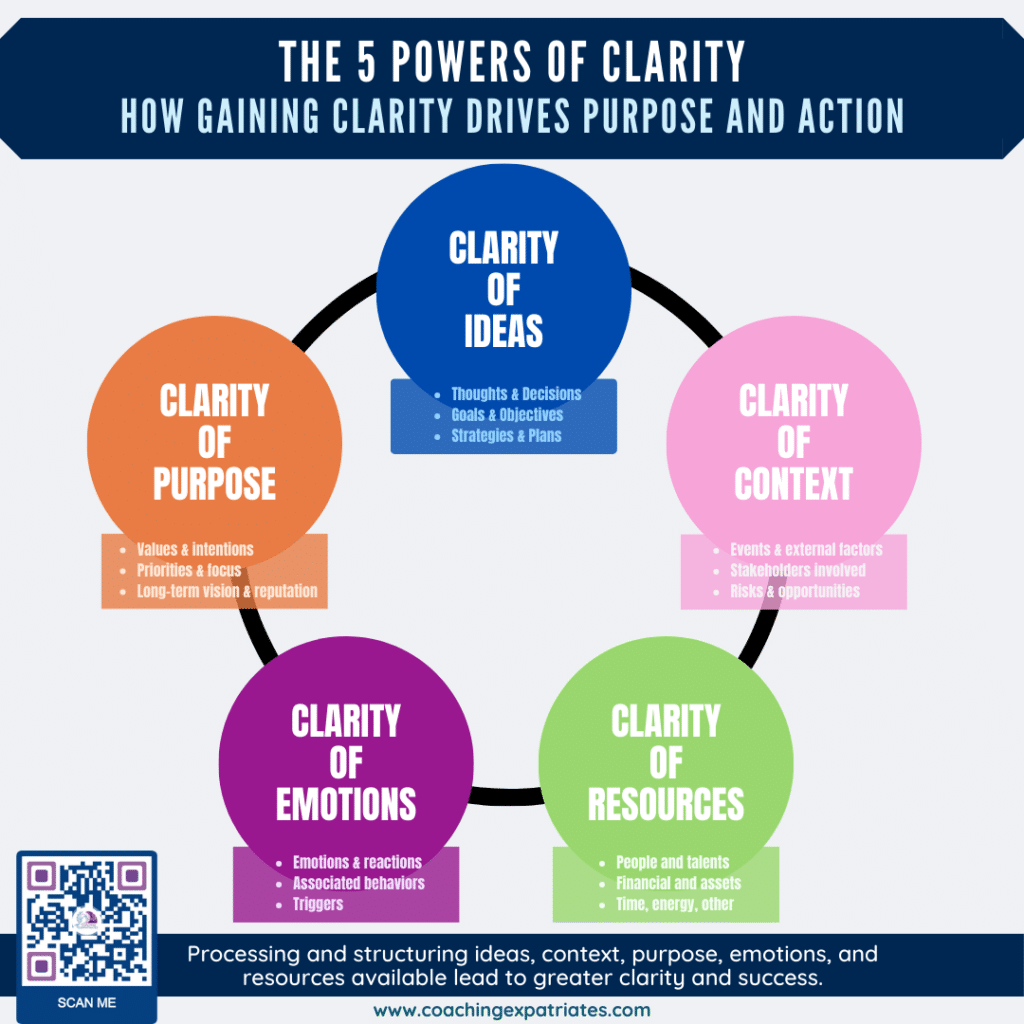
By focusing on these five categories—ideas, context, purpose, emotions, and resources—executives can gain comprehensive clarity to help them act more intentionally. This holistic approach empowers leaders to navigate complex environments, make informed decisions, and lead their organizations toward sustained success.
How To Gain Clarity
STEP 1: Processing Information You Have
Gaining clarity starts with effectively processing the information you already have. People generally fall into two categories when it comes to processing information: verbal processors and internal processors. Understanding how each type works can help you utilize the best strategies for achieving clarity.
Verbal Processors Vs. Internal Processors
Verbal Processors:
- Definition: Verbal processors think out loud and often need to discuss their thoughts with others to make sense of them.
- How Their Minds Work: They articulate their ideas, questions, and concerns by talking, which helps them to organize and refine their thoughts. Verbal processors find it easier to reach clarity by engaging in conversations and hearing their own thoughts articulated.
Internal Processors:
- Definition: Internal processors prefer to think things through quietly and internally before sharing their ideas with others.
- How Their Minds Work: Internal processors are not necessarily analytical minds, like many think. They just need time to reflect and analyze information in their own minds first. Internal processors often write down their thoughts or use other solo activities to structure their thinking before they feel ready to discuss with others. This is what often helps them gain peace of mind or the right frame of mind for new decisions.

Regardless of whether you are a verbal or internal processor, there are strategies you can use to process information effectively:
I. Coaching
- How It Helps: Coaching provides a structured environment to explore your thoughts and ideas. A professional coach asks insightful, powerful questions that guide you through your thinking process, helping you uncover insights and reach clarity.
- Example: An executive working on a new strategic plan might use coaching sessions to explore different approaches, articulate goals, and identify potential challenges.
II. Talking With Mentors
- How It Helps: Mentors offer experience-based advice and perspectives that can help you see your situation from different angles. Discussing your thoughts with a mentor can provide valuable feedback and guidance.
- Example: An HR manager considering a new employee engagement initiative might discuss their ideas with a mentor who has successfully implemented similar programs, gaining practical advice and avoiding common pitfalls.
III. Talking With Coworkers Who Share Context
- How It Helps: Engaging with coworkers who understand the specific context of your situation can lead to more relevant and practical insights. These discussions can help validate your ideas and highlight aspects you may have overlooked.
- Example: A project leader discussing a new workflow process with team members can gather diverse perspectives, ensuring the final plan is comprehensive and feasible.
By understanding whether you are a verbal or internal processor and utilizing coaching, mentoring, and peer discussions, you can process information more effectively and gain the clarity needed for informed decision-making. This approach ensures that you leverage the strengths of your processing style and use available resources to enhance your understanding and clarity.
A Story Of Gaining Clarity
A client once approached me with a challenge: they had been invited to present at a finance forum. While they knew they had plenty of valuable insights to share, they were unsure about what would be the most impactful content to present. As an internal processor, they preferred to reflect on their thoughts quietly before discussing them.
As their coach, I provided them with a series of questions and prompts to ponder before our next session. These prompts were designed to help them identify key themes and messages that would resonate with the forum audience. During our sessions, we structured what they had reflected on, organizing their ideas into a coherent outline.
Together, we developed a detailed script for each section of the outline and created a presentation that would visually support their speech. We also rehearsed the presentation’s ideas together, focusing on key points of delivery and body language to ensure they would appear confident and engaging.
With each session, the client built up and gained more clarity, which in turn boosted their confidence. Here’s how they benefited from the five powers of clarity:
- Clarity of Ideas: By reflecting on and organizing their thoughts, they were able to identify the most valuable insights to share, ensuring a focused and impactful presentation.
- Clarity of Context: Understanding the audience and the forum’s purpose helped them tailor their message to be relevant and engaging.
- Clarity of Purpose: Defining their presentation’s goals and the key messages they wanted to convey gave their speech direction and purpose. Those who stayed for the presentation knew exactly what they’d be getting into.
- Clarity of Emotions: By rehearsing and receiving feedback, they managed their nervousness and built confidence in their delivery despite being a first-time public-presenter.
- Clarity of Resources: Utilizing the available resources—coaching sessions, rehearsal time, and presentation tools—ensured they were well-prepared and supported.

By gaining clarity in these areas, the client not only delivered a successful presentation but also enhanced their confidence and effectiveness as a speaker. This comprehensive approach to clarity allowed them to connect with the audience and share their expertise with a positive impact.
STEP 2: Using Critical Thinking
Critical Thinking Definition:
Critical thinking is all about analyzing information and making thoughtful decisions based on that analysis. Critical thinking is often associated with the question, “Does this make sense?” It’s like being a detective, where you gather clues (information), evaluate them, and then come to a conclusion. In the context of seeking clarity, critical thinking helps you break down complex problems and understand them better so you can make informed choices.
The Power Of Questions:
One of the best ways to use critical thinking is by asking the right powerful questions to gain more clarity. Questions help you dig deeper into a topic and uncover details you might not have thought about. When you ask good questions, you get clearer answers, which helps you understand the situation better.
The 5WH Framework:
A great way to start asking the right questions is by using the 5WH framework. This stands for What, Why, When, Where, Who, and How. If you’ve never heard of this before, I suggest you read next our article on the 5WH. Here’s how each question can help you gain clarity:
What: What is the problem or topic? What information do you need?
- Example: What is causing the drop in employee engagement?
Why: Why is this happening? Why is it important?
- Example: Why are employees feeling disengaged? Why does this matter to our company?
When: When did this issue start? When do we need to resolve it?
- Example: When did we first notice the drop in engagement? When do we want to see improvement?
Where: Where is this issue occurring? Where can we find more information?
- Example: Where are employees most disengaged—in certain departments or locations?
Who: Who is affected by this issue? Who can help resolve it?
- Example: Who are the disengaged employees? Who can provide insights or solutions?
How: How can we address this issue? How will we measure success?
- Example: How can we improve employee engagement? How will we know if our efforts are working?
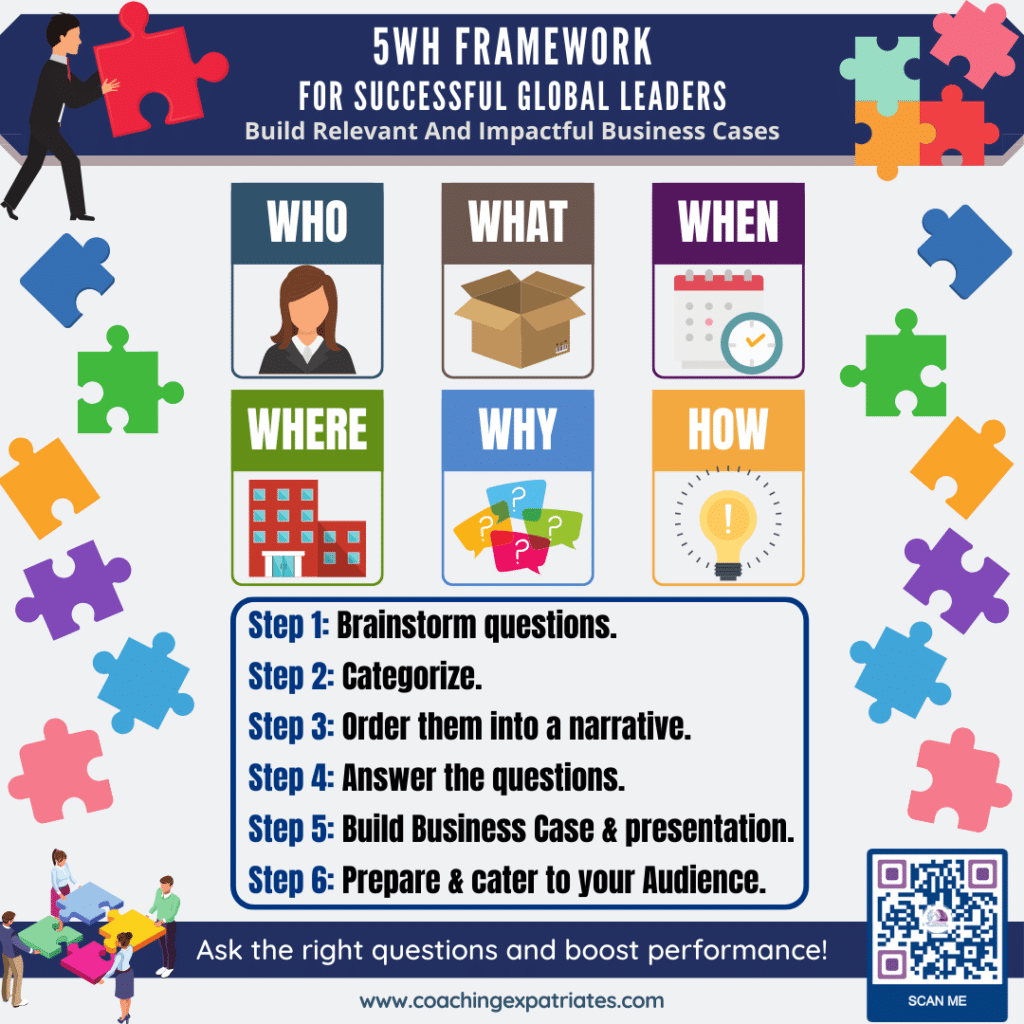
By using these questions, you can outline the fundamental aspects of any topic, making it easier to understand and address. A critical thinking mindset and the 5WH framework together help you gain the clarity you need to make informed decisions and take effective actions.
STEP 3: Collecting New Information To Close Gaps
Collect Data: To gain mental clarity, start by collecting all relevant information, facts, and data related to the topic. Think of it like gathering pieces of a puzzle. The more pieces you have, the clearer the picture becomes.
Example: If you’re trying to improve team productivity, gather data on current productivity levels, work habits, work hours, workload, motivation, and team feedback.
Consult Multiple Sources: Don’t rely on just one source of information. Use diverse and credible sources to ensure you get a well-rounded understanding. Different perspectives can give you new insights that you might not get from a single source.
Example: If you’re researching market trends, look at industry reports, news articles, competitor analysis, and expert opinions.
Analyze Data & Information: After collecting information and data from multiple sources, analyze it to identify patterns and understand what pieces of the puzzle you already have and what might still be missing. This helps you make sense of the information and see the bigger picture. If you are not very good at doing this alone, consider hiring an executive coach to guide you through the thinking process and idea structuring.
Example: Analyze employee survey results, performance metrics, and feedback to see if there are common themes affecting productivity.
Identify Gaps: As you analyze the data, note any missing information or unclear areas. These gaps are like missing pieces of the puzzle that you need to find to complete the picture.
Example: If you notice that you don’t have enough data on why certain employees are less productive, that’s a gap you need to fill.
Close Gaps: Once you’ve identified the gaps, seek out additional information to fill them. This might involve more research, asking follow-up questions, or consulting additional sources.
Example: Conduct follow-up interviews with employees to understand the specific reasons behind their productivity levels.
By following these steps, you can collect new information to close gaps and gain a clearer understanding of any topic. This thorough approach ensures you have all the pieces you need to make informed decisions and take effective actions.
STEP 4: Structuring Ideas/Information
To gain clarity, it’s crucial to structure your ideas and information in an organized way. If one doesn’t do that, they might feel overwhelmed by the wealth of information. Here are some tools and techniques that can help you do this effectively:
Brainstorming: Brainstorming is a great way to generate a lot of ideas quickly. It allows you to think creatively and explore different possibilities without judging them initially.
Example: When planning a new project, gather your team to brainstorm all possible approaches and solutions. This can lead to innovative ideas you might not have considered on your own.
Mindmapping: Mindmapping helps you visually organize information. Not only that, but mind mapping is also an effective method of remembering things better, according to studies with medical students. It starts with a central idea and branches out into related topics, making it easier to see connections and relationships. It’s fun to work on and very useful.
Example: Use a mind map to plan a marketing campaign. Start with the main goal in the center and branch out to ideas for social media, content creation, and target audience.

Role-playing: Role-playing involves acting out scenarios to gain different perspectives and understand potential outcomes. Research shows that it can be extremely beneficial in gaining self-awareness and confidence. This can help you anticipate professional or life challenges and develop better strategies. This can simplify your life because it helps you process information, create and proof a plan, and help you build confidence.
Example: In a role-playing exercise, team members might simulate a difficult client meeting to practice responses and strategies, leading to more effective real-life confident interactions.
Journaling: Journaling involves writing down your thoughts, ideas, and reflections. This helps clarify your thinking by processing all information and making sense of it, and can reveal insights you might not notice otherwise. Research shows it can even help in processing traumatic events. It is a powerful tool to reflect and gain insights.
Example: Keep a journal to record your daily reflections on a project. This can help you track progress, identify issues, and brainstorm solutions over time. My dearest dog Theo had a rare form of cancer called Pheochromocytoma, which is even rarer in animals. Who would have known that keeping a journal with key daily information since he was diagnosed would help us extend his life during palliative treatment?
What-If Scenarios: What-if scenarios involve imagining different possible futures and how you would respond to them. This helps you prepare for various outcomes and develop contingency plans. This is also known for Scenario Analysis.
Example: Create what-if scenarios for potential risks in a new product launch. Consider what you would do if there were delays, budget overruns, or unexpected market reactions.
By using these tools and techniques to structure your ideas and information, you can gain a clearer understanding of your goals and the steps needed to achieve them. You can also often see trends and themes that might lead you to new initiatives. This structured approach ensures that you cover all aspects of your topic and are well-prepared for any challenges that arise.
STEP 5: Defining Actions With The New Clarity
I love to say that Clarity drives action and purpose and, therefore, creates confidence because it’s absolutely true! Although absolute clarity might not exist, once you’ve gained substantial clarity, the next step is to define your actions based on this newfound understanding. Here’s how to decide what to do with the clarity you’ve gained:
Deciding What To Do With The Clarity Gained
This is a simple framework that can be used to decide how is the best way to take action on the recently gained clarity:
1. Define And Set Clear Goals And Expectations:
- Use the clarity you’ve achieved to set specific, actionable goals. Use the famous SMART goals structure to do this. This ensures your actions are aligned with your new insights.
- Example: After gaining clarity on the main causes of low employee engagement, set a goal to implement three new engagement initiatives within the next six months with clear KPIs to measure progress.
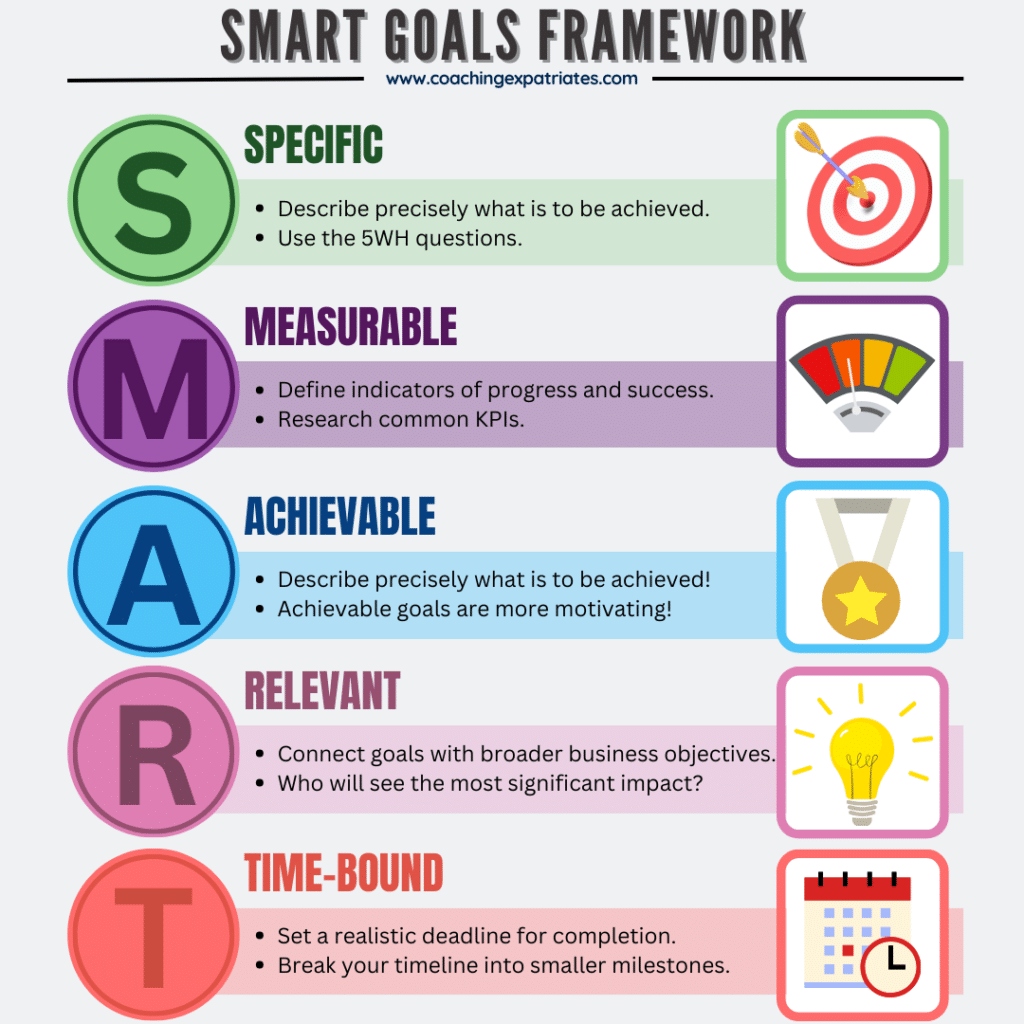
2. Develop A Detailed Plan:
- Create a step-by-step plan that outlines how you will achieve your goals. This plan should include timelines, resources needed, and specific actions to be taken.
- Example: Develop a detailed plan for a new training program, including a schedule, materials needed, and roles and responsibilities.
3. Prioritize Actions:
- Identify the most important actions to take first. Prioritizing helps you focus on what will have the greatest impact.
- Example: If you’ve identified several areas for improvement, prioritize actions that will address the most critical issues first, such as improving team communication.
4. Allocate Resources:
- Determine what resources are needed to execute your plan. This includes time, money, personnel, and any other necessary assets.
- Example: Allocate a budget for new software that will help streamline project management and improve efficiency.
5. Communicate Clearly:
- Ensure that everyone involved understands the plan and their role in it. Clear communication helps align the team and sets expectations.
- Example: Hold a meeting to communicate the new project plan to your team, explaining each person’s responsibilities and how their work contributes to the overall goal.
6. Implement And Monitor:
- Put your plan into action and regularly monitor progress to ensure you are on track. Adjust as needed based on feedback and changing circumstances.
- Example: Start rolling out the new engagement initiatives and set up regular check-ins to monitor their effectiveness and make adjustments if necessary.
7. Reflect And Learn:
- After implementing your plan, take time to reflect on what worked and what didn’t. Use these insights to improve future actions. When I was a CFO in a Life Sciences business, I used to call these reflection meetings “Post Morten.” The reason for this name is that we could not change the after-fact, but we could learn from “dissecting” what happened and learning from it.
- Example: After completing the training program, gather feedback from participants to understand its impact and identify areas for improvement or change.
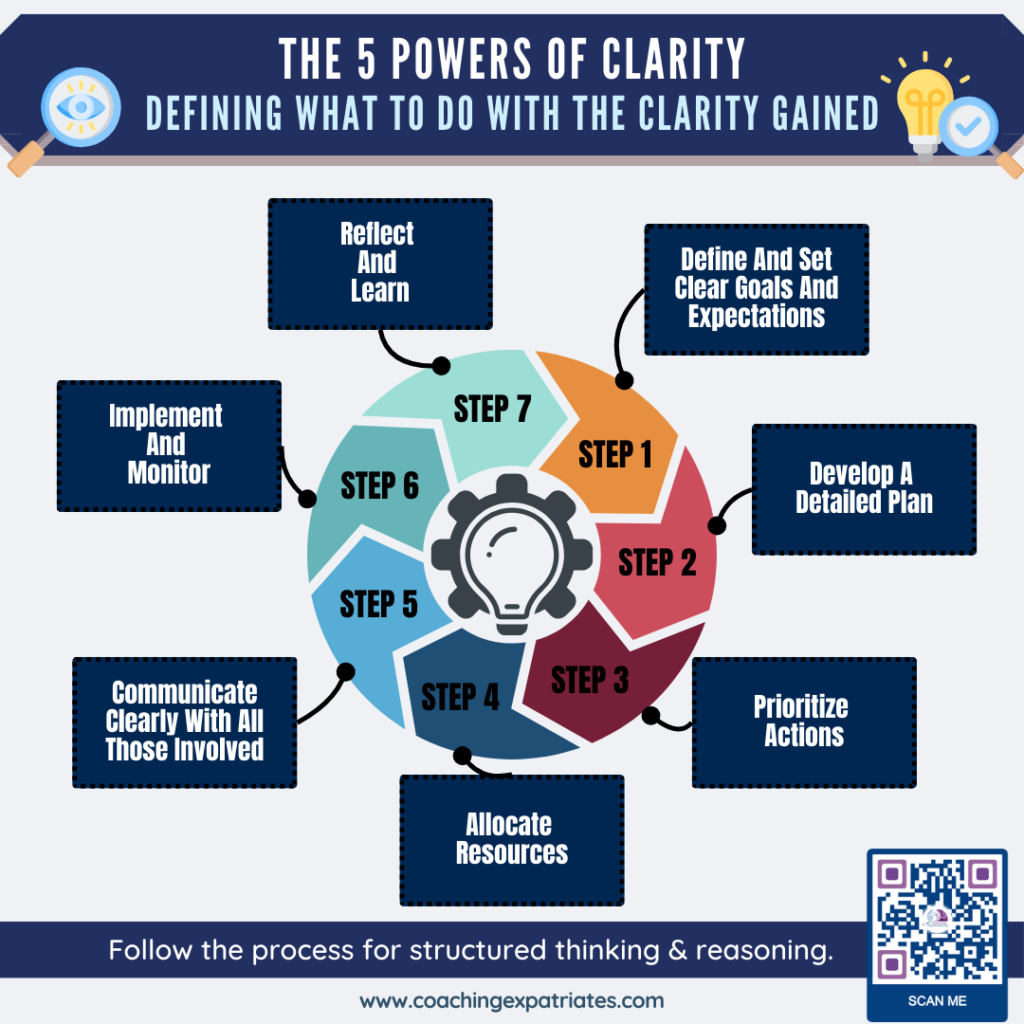
By defining specific actions based on the clarity you’ve gained, you can ensure that your efforts are purposeful and effective. This structured approach helps you move forward with confidence and achieve your desired outcomes.
STUDY CASES
Case Study: Joy's Path To Clarity
Background: Joy was facing a challenging situation. She had recently made a business decision and was worried about discussing it with her Vice President (VP), fearing she would be reproached for her actions. Joy knew she needed to gain clarity on her ideas to confidently convey the logic behind her decision to the VP.
The Coaching Session: During our coaching session, we focused on helping Joy process her thoughts and gain clarity. Here’s how we approached it:
Clarifying And Structuring Ideas: We began by discussing the specifics of Joy’s decision. Joy used the session to talk through her thoughts, which helped her process and gain a deeper understanding of why she made the decision. We worked together to clarify her reasoning and structure her ideas in a logical and coherent way. This process involved:
- Identifying Key Points: Highlighting the main reasons behind her decision.
- Organizing Information: Structuring her thoughts to create a clear narrative that explained her decision logically.
- Anticipating Questions: Preparing for potential questions or concerns the VP might have.
Role-Playing The Conversation: To further build her confidence, we role-played the conversation with the VP. This allowed Joy to practice conveying her message clearly and handling any potential objections. During the role-play, we focused on:
- Effective Communication: Ensuring Joy could articulate her ideas clearly and confidently.
- Body Language: Using confident body language to reinforce her message.
- Emotional Preparation: Helping Joy manage her emotions and stay calm during the actual conversation.
Outcome: By the end of our coaching session, Joy felt full of confidence. She was ready to present her decision with conviction to the VP. When she finally had the conversation, Joy was able to clearly explain the logic behind her decision. Instead of being reproached, she was applauded for her boldness and the conviction of her ideas. The VP decided to support Joy’s decision and commended her for her clarity and leadership.
The Five Powers Of Clarity: Through this process, Joy gained several key powers of clarity:
- Clarity of Ideas: By understanding and structuring her reasoning, Joy could present her decision logically.
- Clarity of Context: She anticipated the VP’s perspective and prepared accordingly, explaining what information and context she had available at the time of the decision.
- Clarity of Purpose: Joy reaffirmed the purpose behind her decision, aligning it with the company’s goals.
- Clarity of Emotions: By managing her emotions, she remained calm and confident during the conversation.
- Clarity of Resources: By understanding the resources involved in her decision, she could present a clear and complete picture to the VP, showing how her decision utilized available assets effectively.
This case demonstrates the transformative power of gaining clarity. By taking the time to clarify her thoughts and prepare thoroughly, Joy not only avoided a potential conflict but also strengthened her position and gained the support of her leadership.
Case Study: Emily's Path To Clarity
Background: Emily came to coaching feeling frustrated with her indecisiveness. Her manager wanted her to become more decisive and autonomous, instead of escalating decisions to him every time. Through our sessions, we uncovered that the root cause of Emily’s indecision was a lack of clarity regarding her authority lane. The company lacked a decision matrix or Table of Delegation of Authority, making it unclear what decisions she could make independently, who she needed to consult, and when she needed approval. This lack of clarity led to frequent decision conflicts among leaders.
The Coaching Session: During our coaching sessions, we focused on understanding the issue and finding a solution. Here’s how we approached it:
Identifying The Problem: We discussed Emily’s experiences and realized that the confusion around decision-making authority was widespread. Other leaders faced similar challenges, leading to conflicts and inefficiencies.
Developing A Solution: Emily decided to take proactive steps to address the issue. We worked together to develop a plan for creating a RACI (Responsible, Accountable, Consulted, Informed) table. This tool would clearly define roles and responsibilities, helping everyone understand their decision-making authority.
Implementing The Initiative: Emily initiated the creation of the RACI table, starting with her own department. Her director appreciated her proactive approach and the clarity it brought. Other stakeholders, seeing the benefits, asked her to expand the initiative to include their areas of management as well.
Outcome: Emily’s initiative led to a company-wide effort to establish a consistent Table of Delegation of Authority with clear roles and responsibilities. This not only helped Emily become more effective and decisive but also improved decision-making across the organization.
The Five Powers Of Clarity: Through this process, Emily gained several key powers of clarity:
- Clarity of Ideas: By identifying the root cause of her indecisiveness, Emily could focus on a practical solution.
- Clarity of Context: Understanding the broader organizational context helped her see the widespread nature of the problem and the potential impact of her initiative.
- Clarity of Purpose: Emily’s goal was clear: to create a tool that would provide decision-making clarity for herself and her colleagues.
- Clarity of Emotions: By addressing the source of her frustration, Emily felt more confident and empowered.
- Clarity of Resources: Emily effectively utilized her understanding of the company’s needs and available resources to develop and implement the RACI table.

This case demonstrates the power of gaining clarity in decision-making roles and responsibilities. By addressing a fundamental gap, Emily not only improved her own performance but also brought about a significant positive change within her organization.
Recommended Books On Gaining Clarity
Here are three highly recommended books available on Amazon or any other big bookstore that can help global executives and HR professionals gain clarity in their roles:
Thinking, Fast And Slow
by Daniel Kahneman (2011)
- Description: In this groundbreaking book, Nobel laureate Daniel Kahneman explores the two systems of thought that drive our decisions: the fast, intuitive, and emotional system, and the slow, deliberate, and logical system. He delves into the biases and errors that affect our thinking and how we can overcome them to make better decisions.
- Why It’s Helpful: For global executives and HR professionals, understanding these cognitive processes is crucial for making clear, informed decisions. By recognizing and mitigating biases, leaders can enhance their decision-making capabilities and foster a culture of rational thinking within their organizations.
The Power of Now: A Guide to Spiritual Enlightenment
by Eckhart Tolle (1997)
- Description: Eckhart Tolle’s “The Power of Now” is a spiritual guidebook that encourages readers to live in the present moment. Tolle explains how focusing on the now can lead to a deeper sense of peace and fulfillment, helping individuals transcend their habitual thoughts and emotional struggles.
- Why It’s Helpful: For executives and HR leaders, learning to stay present can improve focus, reduce stress, and enhance overall clarity. By mastering the art of living in the present, leaders can make more thoughtful and clear-headed decisions, positively impacting their teams and organizations.
Essentialism: The Disciplined Pursuit of Less
by Greg McKeown (2014)
- Description: “Essentialism” by Greg McKeown is a guide to prioritizing what truly matters in both professional and personal life decisions. McKeown advocates for a disciplined approach to focusing on essential tasks and eliminating non-essential ones, thereby achieving greater productivity and fulfillment.
- Why It’s Helpful: For global executives and HR professionals, the principles of essentialism can be transformative. By focusing on what is truly important, leaders can cut through the noise, make better decisions, and lead their organizations more effectively. This book provides practical strategies for gaining clarity on priorities and maximizing impact.
Reading these books can equip executives and HR professionals with the tools and insights needed to enhance clarity in their roles, leading to more effective leadership and organizational success.
Final Remarks
Clarity is the foundation of effective leadership, which you’ll also agree with if you read this entire article. It allows executives and HR professionals to make informed decisions, communicate effectively, and lead their teams with confidence. By understanding and addressing various aspects of clarity—ideas, context, purpose, emotions, and resources—leaders can navigate complexities, anticipate challenges, and seize opportunities. Clarity not only enhances professional performance but also contributes to personal fulfillment and a positive work environment. If you loved this article, I invite you also to read the guides on Ikigai and The Power Of Questions, which will aid you in your pursuit of clarity.
I also encourage you to take a moment to assess your own clarity. Think about something important in your life that might be a source of current struggle or concern. Reflect on your current goals, decisions, and the information you have at hand. Are there areas where you feel uncertain or unclear? Identifying these gaps is the first step toward achieving greater clarity. Use this article’s framework to further explore and gain clarity.
If you find that you need guidance on this journey, consider seeking support. As someone who has navigated these challenges and helped others do the same, I offer my services to be your partner in gaining clarity. Together, we can explore your thoughts, define your goals, and develop a clear plan to achieve success. Don’t hesitate to reach out—let’s work together to bring clarity and confidence to your leadership journey. Schedule a free consultation with me.
If you are interested in developing specific global leadership skills, personally or team-wise, check out our online Global Executive Leadership program. We go over all The Global Leadership Pillars™ during 9 online modules, specially meant for global leadership development. It’s a unique leadership training methodology that will change the way you think, relate, and strategize as a global leader. You can also subscribe to our free global leadership podcast, The Leadership Nest.
If you enjoyed this post, consider subscribing to our newsletter using the form below. We focus on providing good content to global leaders and executives who want to make impactful business decisions and be more inclusive and influential. We know your inbox is sacred, so we email just once per week, and we never sell, rent, or do anything funky with your information. Trust is the basis of Global Leadership, and we fully honor it.

